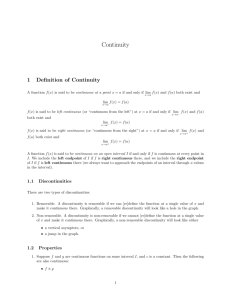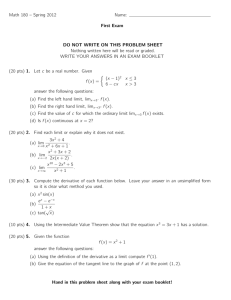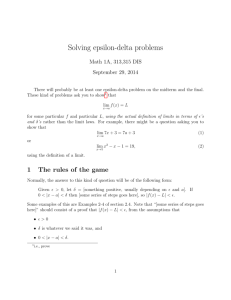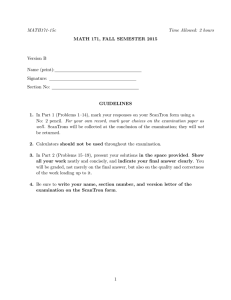Check continuity of functions and determine discontinuities
advertisement
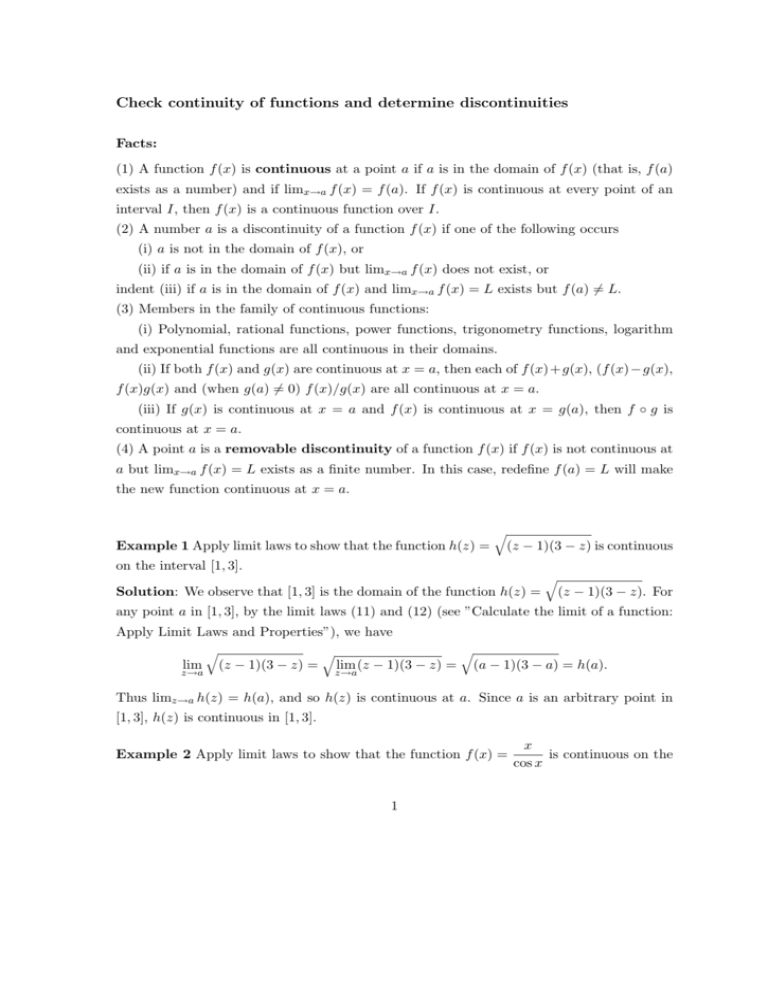
Check continuity of functions and determine discontinuities Facts: (1) A function f (x) is continuous at a point a if a is in the domain of f (x) (that is, f (a) exists as a number) and if limx→a f (x) = f (a). If f (x) is continuous at every point of an interval I, then f (x) is a continuous function over I. (2) A number a is a discontinuity of a function f (x) if one of the following occurs (i) a is not in the domain of f (x), or (ii) if a is in the domain of f (x) but limx→a f (x) does not exist, or indent (iii) if a is in the domain of f (x) and limx→a f (x) = L exists but f (a) 6= L. (3) Members in the family of continuous functions: (i) Polynomial, rational functions, power functions, trigonometry functions, logarithm and exponential functions are all continuous in their domains. (ii) If both f (x) and g(x) are continuous at x = a, then each of f (x)+g(x), (f (x)−g(x), f (x)g(x) and (when g(a) 6= 0) f (x)/g(x) are all continuous at x = a. (iii) If g(x) is continuous at x = a and f (x) is continuous at x = g(a), then f ◦ g is continuous at x = a. (4) A point a is a removable discontinuity of a function f (x) if f (x) is not continuous at a but limx→a f (x) = L exists as a finite number. In this case, redefine f (a) = L will make the new function continuous at x = a. Example 1 Apply limit laws to show that the function h(z) = q (z − 1)(3 − z) is continuous on the interval [1, 3]. Solution: We observe that [1, 3] is the domain of the function h(z) = q (z − 1)(3 − z). For any point a in [1, 3], by the limit laws (11) and (12) (see ”Calculate the limit of a function: Apply Limit Laws and Properties”), we have lim z→a q (z − 1)(3 − z) = q lim (z − 1)(3 − z) = z→a q (a − 1)(3 − a) = h(a). Thus limz→a h(z) = h(a), and so h(z) is continuous at a. Since a is an arbitrary point in [1, 3], h(z) is continuous in [1, 3]. Example 2 Apply limit laws to show that the function f (x) = 1 x is continuous on the cos x interval π π . − , 2 2 π π x is in side the domain of the function f (x) = . Solution: We observe that − , 2 2 cos x π π For any point a in − , , by the limit law (4) (see ”Calculate the limit of a function: 2 2 Apply Limit Laws and Properties”), we have lim x→a limx→a x a x = = = f (a). cos x limx→a cos x cos a Thus limx→a f (x) = h(a), and sof (x) iscontinuous at a. Since a is an arbitrary point in π π − , , f (x) is continuous in 2 2 π π − , . 2 2 1 is continuous. x Solution: Note that f (x) is the sum of a polynomial x2 and a rational function x1 . There- Example 3 Determine where the function f (x) = x2 + fore, the domain of f (x) is (−∞, 0) and (0, ∞). From Facts (3) above, we conclude that f (x) in continuous at every point in (−∞, 0) and (0, ∞). 3 is continuous. x2 − x Solution: Note that f (x) is a rational function x1 . Therefore, the domain of f (x) is (−∞, 0), Example 4 Determine where the function f (x) = (0, 1) and (1, ∞). From Facts (3) above, we conclude that f (x) in continuous at every point in (−∞, 0), (0, 1) and (1, ∞). Example 5 Find discontinuities of the function f (x) = 1 , 1 − |x| and tell whether each of them is a removable discontinuity. Solution: Observe that x = 1 and x = −1 are the only points not in the domain of f (x), and so these are the only discontinuities of f (x). As both limx→1 1 1−|x| and limx→−1 do not exist (as finite numbers), neither of these two points are removable. Example 6 Find discontinuities of the function x+1 f (x) = 3−x 2 if x < 1, if x > 1 1 1−|x| and tell whether each of them is a removable discontinuity. Solution: Observe that x = 1 is the only point not in the domain of f (x), and so this is the only discontinuity of f (x). As lim f (x) = lim 3 − x = 2 and lim f (x) = lim x + 1 = 2, x→1+ x→1− x→1+ x→1− we conclude that lim x → 1f (x) = 2 and so x = 1 is a removable discontinuity of f (x). Example 7 Find a value of c so that the function 2x + c f (x) = 2c − x if x ≤ 3, if x > 3 is continuous. Solution: As polynomials are continuous, we observe that x = 3 is the only problematic point. Compute the side limits, we obtain lim f (x) = lim 2c − x = 2c − 3 and lim f (x) = lim 2x + c = 6 + c. x→3+ x→3− x→3+ x→3− In order for f (x) to be continuous at x = 3, the limit lim x → 3f (x) must exist, and so both side limits must be the same. Thus we equal the two side limits: 2c − 3 = 6 + c to get c = 9. Therefore, c = 9 is the desired. 3




